Energy Recovery Regarding a Circular Economy
| ✅ Paper Type: Free Essay | ✅ Subject: Engineering |
| ✅ Wordcount: 3688 words | ✅ Published: 23 Sep 2019 |
Energy Management, Economics and Risk Analysis
Circular Economy: Energy Recovery
Table of Contents
Circular Economy: Energy Recovery
Figure 1: Linear Economy Model. (Research Gate, 2019)
Figure 2: Circular Economy Model (Stahel, 2016)
Figure 3: From a linear to a circular economy. (Netherland’s Goverment, 2019)
List of Tables
Table 1: Revenue of Korean Companies. (Kim, et al., 2018)
Circular Economy: Energy Recovery

The first law of thermodynamics, also known as Law of Conservation of Energy, states that energy can neither be created nor destroyed; energy can only be transferred or changed from one form to another, (R. Gaskell & Laughlin, 2017). Thus, when talking about a linear economy model of resource consumption that follows a ‘take-make-dispose’ pattern, as seen on figure 1 below; it can be criticized as flawed. The reasoning behind this argument being that, in the linear system, companies extract materials, apply energy and labour to manufacture a product, and sell it to an end consumer, who then discards it when it no longer serves its purpose, finally ending up in a landfill where all its residual energy is lost. (Ellen Macarthur Foundation, 2015).
Figure 1: Linear Economy Model. (Research Gate, 2019)
Hence, the principle of transforming energy into something productive it not achieved because while great strides have been made in improving resource efficiency, any system based on consumption rather than on the restorative use of resources entails significant losses all along the value chain, as stated by (Stahel, 2016), and it’s also no longer a tenable model within the limits of our planet. (Het Groene Brein, 2018). As a result, the need to find an appropriate alternative arose. Fortunately, there is a model that is receiving increasing attention worldwide as a way to overcome the current production and consumption model, based on continuous growth and increasing resource throughput. This alternative is called circular economy, which turn goods that are at the end of their service life into resources for others, closing loops in industrial ecosystems and minimizing waste. It would change the way economic logic is perceived because it replaces production with sufficiency. Basically, placing its fundamentals in the principles of reuse what you can, then recycle what you cannot; also, repair what is broken, and remanufacture what you cannot. This can be seen on the model representation in figure 2. Consequently, the central focus of this paper will be on emphasising how the circular economy model is applied in the aspect of energy recovery across multiple industrial sectors, as well as what are the advantages perceived, and the economic, environmental & business impact related to applying this economy model.
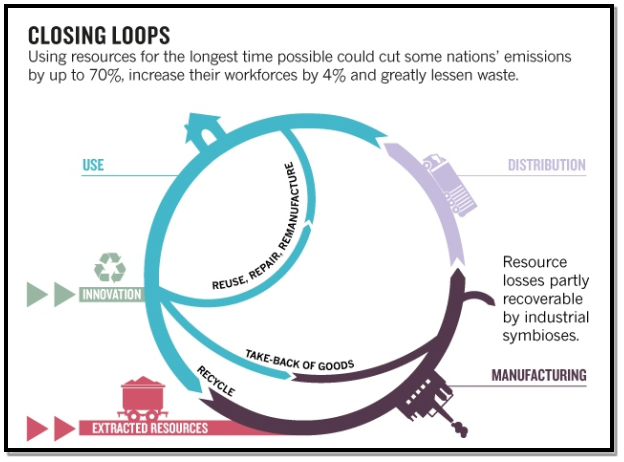 Figure 2: Circular Economy Model (Stahel, 2016)
Figure 2: Circular Economy Model (Stahel, 2016)
One industry that is applying this circular economy model to its aftermath residue is the sugar industry. There are two secondary by products worth mentioning in this industry: the sugarcane bagasse ash and sugarcane straw. The first, sugarcane bagasse ash is burnt in the cogeneration boilers to produce steam energy to spin turbines for electricity generation and to heat up cane juice. The characteristics of bagasse ash will depend up on the process (imbibition or diffusion) adopted for juice extraction. Most of the sugar mills in India and Brazil use imbibition method while diffusion process is common in Europe, South Africa, Central America and Egypt (Bizzo, 2014). The second one, sugarcane straw comes from the residue the mechanical harvester leaves behind. The average Gross Calorific Value (GCV) of sugarcane straw (including cane, tops and leaves) is about 16 MJ/kg (Deepchand, 1986), this high calorific value of sugarcane straw makes it a potential fuel in the cogeneration system. (Gopinath, Bahurudeen, Appari, & Nanthagopalan, 2018). Furthermore, the article “Product design and business model strategies for a circular economy” (Nancy M. P. Bocken, 2015), states that AB sugar, the UK’s largest sugar producer by market share, has evolved their business model into a circular economy to include the use of their by-product baggage as an additional profitable source of income.
Another industry, located in the Netherlands, applying the circular economy model is the government’s Water Authority Institution which no longer regards wastewater as merely a waste to be treated and processed, but as a valuable source of renewable energy, raw materials and clean water. This is being done by converting many of the traditional Sewage Treatment Plants (STPs), into Energy and Raw Materials Factories (ERMFs), which are resource factories that can contribute significantly to achieving circular economies. Moreover, in order to comply with the national policy plans towards a circular economy and greener future, they are focusing on the retrieval of at least five resources from municipal wastewater: cellulose, bioplastics, phosphate, bio-ALE, and biomass. Currently, approximately 100 digesters are operational and biogas (a mixture of CH4 and CO2) is being produced from biomass. (Leeuwen, Vries, Koop, & Roest, 2018). The current production of biogas is 107 million m3 per year as reported by Statistics Netherlands (Haag & Heerlen, 2019). With a price of € 0.20 per m3, this is a revenue of €24 million per year that is expected to increase by 2030 to a total revenue of €40 million per year. This covers almost 40% of the energy consumption of the water authorities, (Nieuwenhuijzen, Sanders , Visser , Odegard , & Bergsma , 2016). In the near future, it can be expected that the water authorities will be self-supporting regarding energy, when they combine it further with wind, solar, and geothermal energy, or even become net producers of energy as in the case of the city of Hamburg. (Bertram & Leeuwen, 2013).
Additional industries have also taken the path towards a circular economy model by implementing industrial symbiosis in their companies. The concept of industrial symbiosis was defined by (Cutaia, Scagliarino, Mencherini, & La Monica, 2016) and (Mulrow, Derrible, Ashton, & Chopra, 2017) through quoting (Chertow, 2000) when he stated it as the process of “engaging traditionally separate industries in a collective approach to competitive advantage involving physical exchange of materials, energy, water, and by-products. The keys to IS are collaboration and synergistic possibilities offered by geographic proximity”. Moreover, in a more nominal approach industrial symbiosis is just the pathways that a resource must take to shift from being a company’s output to another company’s input. For instance, (Cutaia, Scagliarino, Mencherini, & La Monica, 2016) in their case study of “Project Green – Industrial Symbiosis”, studied 13 companies of the agro-industrial sector and 7 laboratories, from where 3 pathways of industrial symbiosis were chosen, in which waste from the food industry outputs were destined as inputs for other companies for the production of biopolymers, nutraceuticals and energy recovery. Likewise, Korea took the initiative by applying industrial symbiosis to their eco-industrial parks and achieving circular networking of resources, as well as energy and waste. In addition, table 1 describes the revenues as well as the environmental benefit of 14 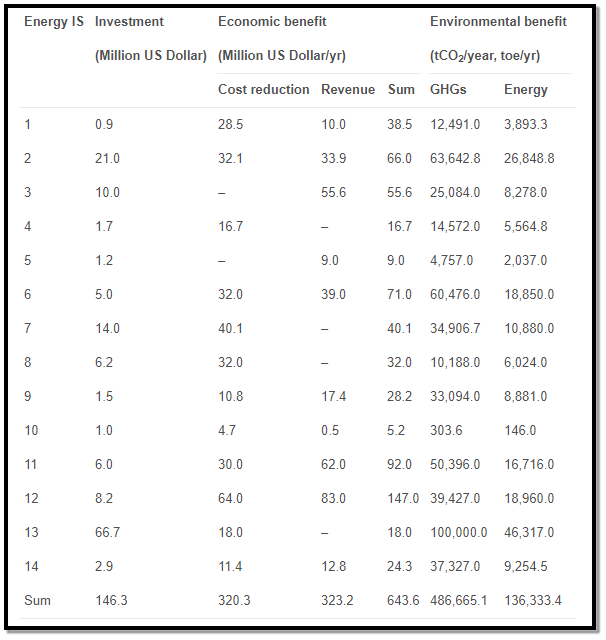 different Korean companies that implemented this economy model. (Kim, et al., 2018).
different Korean companies that implemented this economy model. (Kim, et al., 2018).
Table 1: Revenue of Korean Companies. (Kim, et al., 2018)
Similarly, China took the same methodology and applied it in the Hai Hua Industrial Symbiosis Park located in the Weifang Binhai Economic and Technological Development Zone (WBETDZ) in Shandong Province, China; where key participating companies such as a salt field, a soda plant, a thermal power plant, a bromine plant, a saleratus plant, a potassium sulphate plant, a calcium chloride plant, a petrochemical company, and a chlor-alkali colophony plant combined and created an industrial symbiotic park from where everyone could benefit by providing outputs which became inputs in other companies’ process lines. Further down, a table describing the relationship between the companies and how they share their 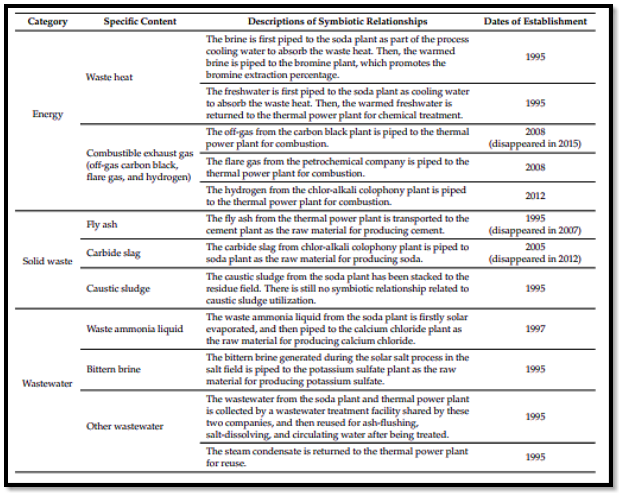 outputs. (Cui, Liu, Côté, & Liu, 2018)
outputs. (Cui, Liu, Côté, & Liu, 2018)
To conclude circular economy business models, fall in two groups: those that foster reuse and extend service life through repair, remanufacture, upgrades and retrofits; and those that turn old goods into as-new resources by recycling the materials. Yet a lack of familiarity and fear of change has resulted in a passive change from linear economy to circular economy models. The reasoning behind this being that economists who are taught to work towards an increase of the gross domestic product (GDP), which measures a financial flow over a period of time; creating wealth by making things last is the opposite of what they have learned. However, concerns over resource scarcity, ethics and safety as well as greenhouse-gas reductions are shifting the methodology to seeing materials as assets to be preserved, rather than continually consumed. A circular economy must be viewed as a close loop system where reprocessing of goods and materials generate jobs and save energy while reducing resource consumption and waste. Moreover, companies all around the world should start their approach towards achieving circular economy because as seen by the examples provide above this type of model provides great economical revenue but above all provides the opportunities for a greener and more ecological 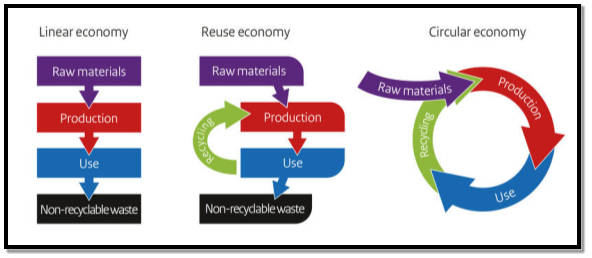 future for upcoming generations.
future for upcoming generations.
Figure 3: From a linear to a circular economy. (Netherland’s Goverment, 2019)
Bibliography
- Bertram, N., & Leeuwen, V. (2013). Baseline assessment and best practices in urban watercycle services in the city of Hamburg. International Journal of Water Management, 10-16.
- Bizzo, A. (2014). The generation of residual biomass during The production of bio-ethanol from sugarcane, its characterization and its use in energy production. Renewable and Sustainable Energy Reviews, 589-603.
- Boulding, K. (1966). The economy of the coming spaceship earth. San Francisco: W.H. Freeman .
- Chertow, M. (2000). Industrial symbiosis: Literature and taxonomy. Annual Review of Energy and the Environment, 313–337.
- Cui, H., Liu, C., Côté, R., & Liu, W. (2018). Understanding the Evolution of Industrial Symbiosis. Sustainability, 3873.
- Cutaia, L., Scagliarino, C., Mencherini, U., & La Monica, M. (2016). PROJECT GREEN SYMBIOSIS 2014 – II PHASE. RESULTS FROM AN INDUSTRIAL SYMBIOSIS PILOT PROJECT IN EMILIA ROMAGNA REGION (ITALY) . Environmental Engineering and Management Journal , 1949-1961.
- Deepchand, K. (1986). Characteristics, present use and potential of sugar cane tops and leaves. Agricultural Waste, 139-148.
- Ellen Macarthur Foundation. (2015). Ellen Macarthur Foundation. Retrieved from https://www.ellenmacarthurfoundation.org/assets/downloads/publications/Ellen-MacArthur-Foundation-Towards-the-Circular-Economy-vol.1.pdf
- Gopinath, A., Bahurudeen, A., Appari, S., & Nanthagopalan, P. (2018). A circular framework for the valorisation of sugar industry wastes: Review on the industrial symbiosis between sugar, construction and energy industries. Journal of Cleaner Production, 89-108.
- Haag, D., & Heerlen. (2019, January). Energy balance sheet; supply and consumption: Statistics Netherlands. Retrieved from Statline: https://statline.cbs.nl
- Het Groene Brein. (2018). Cicular Economy: Kenniskaarten hetgroenebrein. Retrieved from kenniskaarten.hetgroenebrein.nl: https://kenniskaarten.hetgroenebrein.nl/en/knowledge-map-circular-economy/how-is-a-circular-economy-different-from-a-linear-economy/
- Kim, H.-W., Dong, L., SyChoi, A. E., Fujii, M., Fujita, T., & Park, H.-S. (2018). Co-benefit potential of industrial and urban symbiosis using waste heat from industrial park in Ulsan, Korea. Resources, Conservation and Recycling, 225-234.
- Leeuwen, V., Vries, E. d., Koop, S., & Roest, K. (2018). The Energy & Raw Materials Factory: Role and Potential Contribution to the Circular Economy of the Netherlands. Enviromental Management, 786-795.
- Mulrow, J., Derrible, S., Ashton, W., & Chopra, S. (2017). Industrial Symbiosis at the Facility Scale. Journal of Industrial Ecology, 1-10.
- Nancy M. P. Bocken, I. d. (2015). Product design and business model strategies for a circular economy. Journal of Industrial and Production Engineering, 308-320.
- Netherland’s Goverment. (2019, January 14). Circular Economy: Goverment. Retrieved from Goverment.nl: https://www.government.nl/topics/circular-economy/from-a-linear-to-a-circular-economy
- Nieuwenhuijzen, V., Sanders , M., Visser , C., Odegard , I., & Bergsma , G. (2016). The sustainability of the ERMF, a life cycle assessment (in Dutch). H2O-Online, 1.
- R. Gaskell, D., & Laughlin, D. E. (2017). Introduction to the Thermodynamics of Materials. Boca Raton: CRC Press.
- Research Gate. (2019, January 14). Figure: Research Gate. Retrieved from Research Gate Web SIte: https://www.researchgate.net/figure/The-linear-economy-The-take-make-and-waste-approach-of-production_fig2_323809440
- Stahel, W. R. (2016). The circular economy. Nature, 1.
- Turner, & Pearce. (1989). Economics of Natural Resources and the Environment. London: Il Mulino.
Policies of Energy Recovery Regarding a Circular Economy
Table of Contents
Policies of Energy Recovery Regarding a Circular Economy
List of Tables
Table 2: The Waste Hierarchy. (European Commission, 2019)
Table 3: Waste to Energy Legislations (Sakai, et al., 2011)
Table 3: Cont. Waste to Energy Legislations (Sakai, et al., 2011)
Table 3: Cont. Waste to Energy Legislations (Sakai, et al., 2011)
Policies of Energy Recovery Regarding a Circular Economy
One of the principal goals of a circular economy is to have a positive effect on the ecosystem by counteracting the overload and the exploitation of the environment’s resources. A circular economy has the potential to achieve a reduction in emissions by reusing primary materials, closing loops in industrial ecosystems, optimization agricultural productivity, minimizing waste and decreasing negative externalities. However, current policies and legislation are generally written in and for a linear economy which as a result may hinder the transition to a circular economy model. According to research done by (Stewart, Bey, & Boks, 2016), regulation and policies are a common difficulty in circular economy models because of multiple, complex, changing regulations or to a lower extent, a matter of low legislative pressure in the context of production, and product-supply chain approaches, moreover, regulations may also, to some extend limit the scope of innovation for value proposition approaches. On the other hand, despite all the obstacles circular economy faces, for example, the fact that it is an issue that spans across multiple interfaces of the government, which makes it difficult to drive it forward because it is never politically enough (The Chartered Institution of Wastes Management (CIWM), 2014); many countries are aligning their goals to reach a circular economy model by implementing policies that could help achieve goals like fewer emissions, land productivity and soil health, economic growth, substantial resource savings, employment growth and incentive for innovation. (Ellen Macarthur Foundation, 2016). Thus, the main focus of this paper will be to review different policies, regarding energy recovery in a circular economy, that are currently being implemented around the world to achieve a more sustainable future.
Firstly, one of the countries that is currently implementing multiple policy measures to stimulate the change towards a circular economy, is the Netherlands, with their Green Deal approach which forms part of the green growth policy and is a joint initiative by the Dutch Ministries of Economic Affairs (EZ), Infrastructure and the Environment (I&M) and the Interior and Kingdom Relations (BZK). Their aim is to eliminate obstacles to help sustainable initiatives get off the ground and to fast-track this process where possible. Moreover, the Green Deal approach is one element in a standard range of policy instruments that is used to supplement existing instruments, such as legislation and regulation, market and financial incentives, and measures to stimulate innovation. Furthermore, it is particularly suitable when innovations are actually put into practice, a phase during which projects often encounter barriers. Green Deal brings Central Government closer to companies, stakeholder organizations and interest groups, by giving the government a more readily identifiable presence and a clear point of contact to other parties, (Green Deal , 2019). In addition, one example of a Green Deal related to energy recovery, retrieve from “Assessment of green deals related to sustainable heat” (Niessink & Uslu, 2018), is the one where the municipality of Amsterdam was involved in a Green Deal with a waste to energy company AEB (Afval Energie Bedrijf) Amsterdam, with the objective to expand the heat network in order to be able to utilise heat from the waste to energy plant. Back in 2011, the goal was to connect 4,000 home equivalents per year to the heating network leading to 50-80% CO2 reduction per residential connection. The distribution network had grown from 680 connections in 2009 to almost 10,000 connections in 2015 and supplied 0.6 PJ of heat. (Menkveld, Matton, Segers, Vroom, & Kremer , 2017). Additionally, in table 1, there is a list of the most relevant Green Deals 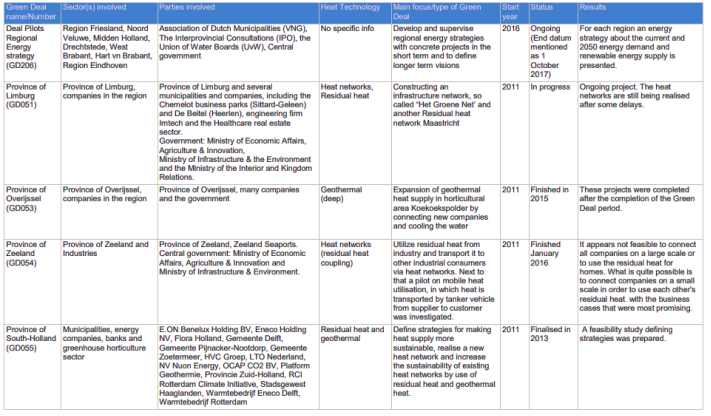
regarding heat supply by provinces.
Secondly, the European Union member countries are also implementing policies to achieve a more circular economy, where the value of products, materials and resources is maintained in the economy for as long as possible and the generation of waste is minimised. Such transition, is the opportunity to transform the economy by implementing legislative proposals on waste, adopting them together with action plans that include long-term targets to reduce landfilling and to increase preparation for reuse and recycling of key waste streams such as municipal waste and packaging waste. Moreover, these targets should lead Member States to gradually converge on best practice levels and encourage the requisite investment in waste management, (European Commision, 2017). Currently, EU is applying the Waste Framework Directive (WFD), (Directive 2008/98/EC on waste), which lays down some basic waste management principles. For instance, it requires that waste be managed without endangering human health and harming the environment, and in particular without risk to water, air, soil, plants or animals, without causing a nuisance through noise or odours, and without adversely affecting the countryside or places of special interest. In addition, the waste hierarchy principle (Art 4 WFD) establishes a 5-step priority order with waste prevention as the most preferable solution, followed by preparation for re-use, recycling, other recovery (including energy recovery) and waste disposal as the last resort. According to Art 4(2) WFD, Member States should encourage those waste management options that deliver the best overall environmental outcome taking into account life-cycle thinking, as seen on the waste 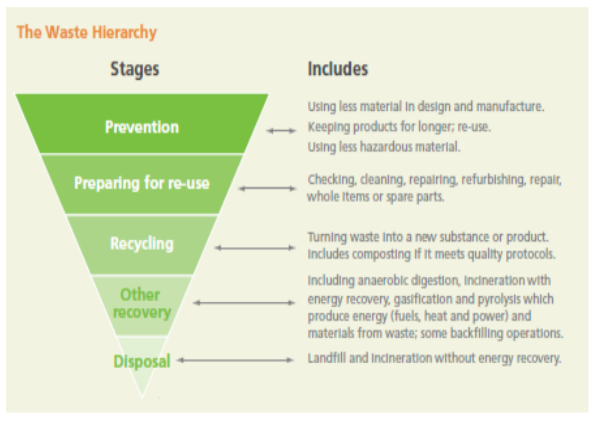
management hierarchy located in table 2. (European Commission, 2019).
Table 2: The Waste Hierarchy. (European Commission, 2019)

Thirdly, as it can be seen on table 3, many countries around the world like USA, EU, Japan, Korea and Vietnam have been working hard in order to achieve polices to regulate issues driven by global environmental problems like the depletion of natural resources. The major focus of waste management policies changed during the late twentieth and early twenty-first centuries. Formerly, the focus was on promoting environmentally sound waste treatment to avoid local environmental pollution, whereas policies have shifted to pursue the concept of sustainability by introducing and promoting 3R policies (Reduce, reuse, and recycle). (Sakai, et al., 2011). Consequently, the need of creating policies and regulation that could regulate a conglomerate of countries arose. The first example, was the Kyoto Protocol adopted on December 11th, 1997. Which focused on making the member countries reduce their greenhouse gas emissions, based on the scientific consensus that global warming is occurring and it is extremely likely that human-made CO2 emissions have predominantly caused it. (Michaelowa, Butzengeiger, Jung, & Dutschke, 2019). However, because the lack of solutions for: the growing shortage of materials, increased pollution, increased material demand and the growing demand for responsible products; another agreement was formalized. The Paris Agreement is an agreement within the United Nations Framework Convention on Climate Change (UNFCCC), dealing with greenhouse-gas-emissions mitigation, adaptation, and finance, starting in the year 2020. (United Nations , 2019). Moreover, its long-term goal is to keep the increase in global average temperature to well below 2 °C above pre-industrial levels; and to limit the increase to 1.5 °C, since this would substantially reduce the risks and effects of climate change, (United Nations Treaty Collection, 2015).
Table 3: Waste to Energy Legislations (Sakai, et al., 2011)
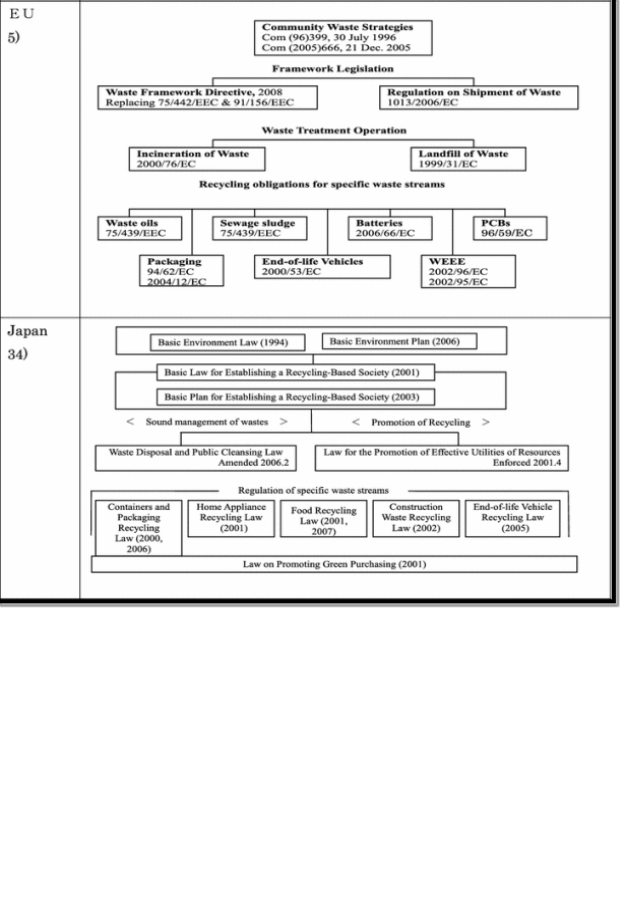 Table 3: Cont. Waste to Energy Legislations (Sakai, et al., 2011)
Table 3: Cont. Waste to Energy Legislations (Sakai, et al., 2011)

Table 3: Cont. Waste to Energy Legislations (Sakai, et al., 2011)
To conclude, recent changes in our world’s atmosphere as a result of increased amount of CO2 emissions and greenhouse gases have caused a severe climate change (United States Environmental Protection Agency, 2016), which is directly link to a linear economy model of resource consumption that follows a ‘take-make-dispose’ pattern (Ellen Macarthur Foundation, 2015), that has become unfeasible for our planet. Hence, the need of changing the linear economy model towards a circular economy model. Furthermore, in order to achieve this transition new policies and regulations must be created and implemented to accomplish common goals like fewer emissions, economic growth, substantial resource savings, employment growth and incentive for innovation. As a result, countries worldwide are opting for implementing polices and regulations like the Green Deal approach, Waste Framework Directive, The Paris Agreement, among others, to mitigate and reduce the risks and effects of climate change by pursuing the concept of sustainability while introducing basic principles like the 3Rs (Reduce, Reuse and Recycle), which in turn will lead to a more sustainable future for upcoming generations.
Cite This Work
To export a reference to this article please select a referencing stye below:
Related Services
View allDMCA / Removal Request
If you are the original writer of this essay and no longer wish to have your work published on UKEssays.com then please click the following link to email our support team:
Request essay removalRelated Services
Our academic writing and marking services can help you!

Freelance Writing Jobs
Looking for a flexible role?
Do you have a 2:1 degree or higher?
Study Resources
Free resources to assist you with your university studies!



